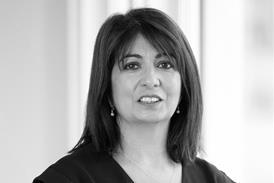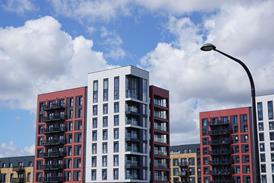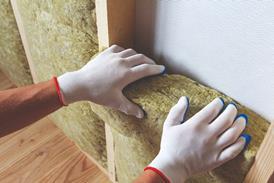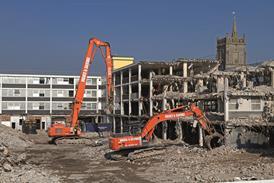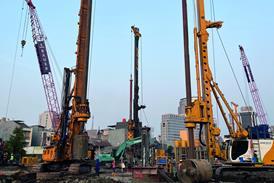Both halves are important to the Integer ethos, points out Nick Thompson, project leader of Cole Thompson Associates. "On one side, the green roof is creating oxygen and lowering CO2 levels. The glazed side traps solar energy and creates the right environmental conditions for the home and an inside-outside section to the house."
This is the first time in the UK that greenhouse-conservatory and grass roof technologies have been exploited within a single house. The steel-framed conservatory has been added to the house to form a temperate zone between outdoors and indoors, an internal garden with the benefits of sunlight, sun warmth, a healthy oxygenated atmosphere – courtesy of a scattering of plants – and a small pond with running water that humidifies the building, masks traffic noise and soothes residents.
The house proper is a highly insulated timber-framed box with Western Red Cedar cladding and a roof planted with grass – a simple solution whose elements have been sourced to ensure the end product really is as sustainable and green as it looks.
The conservatory comes from Queensbury Structures, a company more used to providing glasshouses for Kew Gardens. At 8.5 m wide, between 3.8 m and 5.6 m deep, and 10 m high to its apex, the domestic conservatory was a relatively small project for Queensbury in terms of size and value, but required a considerable amount of design effort because of the need to join the conservatory to the timber house.
"Interfacing was complex," says Steve Collis, director of Collis Structural Design, Queensbury's design partner. "Steel, timber and concrete [at foundation level] all move differently, they all have different build tolerances." Collis worked directly with timber frame specialist Guildway, swapping drawings over the Internet as detailed design progressed.
On-site erection was also critical, recalls Collis. "The conservatory was going on site last. As glazing systems are not very forgiving, we had to ensure that everything would be built to acceptable tolerances." Those tolerances were around 6 mm.
The conservatory is made from standard commercial glasshouse components. It is single-glazed and has a steel frame of seven 197 mm diameter posts with purlins at 1800 mm centres. Aluminium glazing bars are located at 620 mm centres.
Glass is laminated for safety and provided with one of two different forms of protection from solar heat and glare. For the walls, glazing has been coated in a tinted film; the roof glazing, which receives more direct sunlight, is equipped with blinds that provide between 30% and 85% shading. Made from aluminium foil strips on a netting mesh, the blinds are programmed to respond according to the brightness of sunlight, although there is a manual override.
Also automatically controlled are the ventilation louvres, located at base, mid-point and top of the conservatory, which allow cool air in at lower level and hot air out at higher level. Louvres are currently set to open when the temperature passes 25ºC – but again, their activity can be varied by home occupants.
The 45º pitch of the roof should give rainwater sufficient velocity to cleanse the glass, eliminating window-cleaning bills. This relatively steep roof pitch is also central to the geometry of the house, making it possible to accommodate 68.4 m2 of conservatory over three floors. At ground level the conservatory is a 40.7 m2 room in its own right; at first floor the main living area opens on to it via a 7.2 m2 balcony and spiral staircase; at second floor a 20.5 m2 sunspace looks on to the conservatory along one side and shares its glazed roof.
Milking the sun's power
Solar energy is harvested at high level on the south-west facing side of the roof via three collectors. On sunny summer days the 1200 mm × 1 m Thermomax evacuated solar collector is capable of meeting the house's hot water demand and providing water to a temperature of 95ºC. Two 0.5 m × 1 m Solarex photovoltaic panels, with a maximum output of 60 W, collect energy which is stored in batteries in the loft space and used to power extract ventilation.
The north-east facing roof is planted with sedum, an alpine plant that looks similar to grass. The sedum is pre-grown and rolled out like turf on top of a mineral wool layer. Beneath this is a lattice of timber fitted at 1m centres, which is only needed to temporarily stabilise the sedum and biodegrades in time. This sits above a root-resistant capping sheet, an underlayer and polyurethane insulation. Lastly, there is a vapour barrier over the plywood roof deck.
As the green roof is at a pitch of 30º, householders might find the prospect of mowing the lawn daunting, but in reality there is no need for them to do any serious rooftop gardening. The slow-growing sedum does not need cutting and requires little or no other attention, whether the English summer is a soaker or a scorcher.
"It retains up to 95% moisture, so once it has been replenished it can go for up to 10 months without watering or rain," says Graham Spall, technical manager of green roof specialist Erisco Bauder. "The only maintenance it requires is the application of a slow-release fertiliser once a year, a job that takes 10 minutes."
Although the Integer house only has a two-year planning permission, its roof's waterproofing has a life of up to 70 years, and the sedum should live indefinitely. The 50 m2 of planting also has clear environmental benefits in generating oxygen, absorbing CO2, and attracting birds and insects.
Environmental friendliness and cost competitiveness were the prime reasons for the choice of Western Red Cedar for the cladding. "When we first started designing the house we considered hanging clay tile and liked it, but we were put off by its cost," says Craig Anders, project architect with Cole Thompson Associates. "We used cedar because it is a sustainable, natural product, it is low maintenance, and it is easy to handle on site as it can be fitted by regular joiners." The cladding is fitted horizontally to 38 mm × 38 mm vertical softwood battens.
The Western Red Cedar will, in time, weather from its current rich orange hue to a dull grey. The timber has not been treated; instead, naturally occurring oils in the wood will naturally resist decay. The architect puts the life expectancy of the cladding at 80 years plus, a lifespan that has already been verified by the cedarwood bungalows built by car maker Herbert Austin for his workers at Austin Village, Longbridge, near Birmingham, in 1917.
Cedar was supplied by Vincent Timber and came from the forests of British Columbia, via Canada's Council of Forest Industries. Although imported rather than home-grown, the timber is a sustainable option, according to Anders, as British Columbia has a considerable forest resource and shipping does not add substantially to embodied energy content. For the past three-and-a-half years, British Columbia's forests have been subject to a Forest Practices Code, backed by legislation, which promotes sustainability and protects biodiversity. As Anders points out, the project's timber comes "with all the right paperwork".
Source
Building Homes




